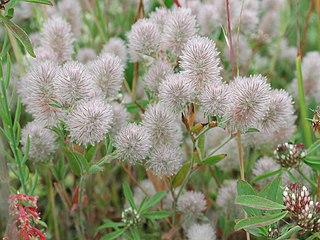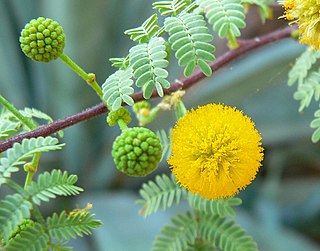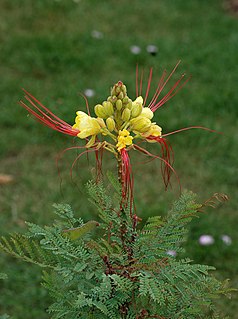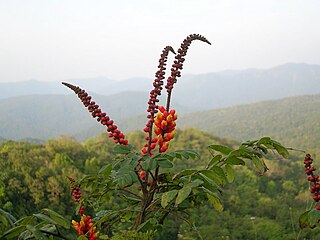
Oxyria digyna is a species of flowering plant in the buckwheat family (Polygonaceae). It is native to arctic regions and mountainous parts of the Northern Hemisphere.

Lathyrus japonicus is a legume native to temperate coastal areas of Asia, Europe, and North and South America.

Albizia julibrissin is a species of tree in the family Fabaceae, native to southwestern and eastern Asia.

Trifolium arvense, commonly known as hare's-foot clover, rabbitfoot clover, stone clover or oldfield clover, is a flowering plant in the bean family Fabaceae. This species of clover is native to most of Europe, excluding the Arctic zone, and western Asia, in plain or mid-mountain habitats up to 1,600 metres (5,200 ft) altitude. It grows in dry sandy soils, both acidic and alkaline, typically found at the edge of fields, in wastelands, at the side of roads, on sand dunes, and opportunistically in vineyards and orchards when they are not irrigated.

Libidibia coriaria is a leguminous tree or large shrub native to the Caribbean, Mexico, Central America, and northern South America. Common names include Divi-divi, Cascalote, Guaracabuya, Guatapana, Nacascol, and Watapana (Aruba).

Diospyros nigra, the black sapote, is a species of persimmon. Common names include chocolate pudding fruit, black soapapple and zapote prieto. The tropical fruit tree is native to eastern Mexico, the Caribbean, Central America, and into Colombia. The common name sapote refers to any soft, edible fruit. Black sapote is not related to white sapote nor mamey sapote.

Tara spinosa, commonly known as tara (Quechua), is a small leguminous tree or thorny shrub native to Peru. T. spinosa is cultivated as a source of tannins based on a galloylated quinic acid structure. This chemical structure has been confirmed also by LC-MS. It is also grown as an ornamental plant because of its large colorful flowers and pods.

Vachellia nilotica is a tree in the family Fabaceae. It is native to Africa, the Middle East and the Indian subcontinent. It is also a Weed of National Significance and is an invasive species of significant concern in Australia.

Vachellia constricta, also known commonly as the whitethorn acacia, is a shrub native to Mexico and the Southwestern United States, with a disjunct eastern population in Virginia and Maryland.
Vachellia nubica is a species of legume in the Fabaceae family.

Erythrostemon gilliesii is a shrub in the legume family. It is commonly known as bird of paradise, but it is not related to the bird of paradise genus Strelitzia. It grows to 1–4 m tall, depending on rainfall. The leaves are bipinnate, 10–15 cm long, bearing 3-10 pairs of pinnae, each with 6-10 pairs of leaflets 5–6 mm long and 2–4 mm broad. The flowers are borne in racemes up to 20 cm long, each flower with five yellow petals with 10 long conspicuous red stamens. The pods are densely covered in short, red glandular hairs.

Astragalus trichopodus is a species of legume known by the common name Santa Barbara milk vetch. It is native to southern California and Baja California, where it grows in several types of open habitat, including in the Transverse Ranges and Mojave Desert.
Astragalus asymmetricus is a species of milkvetch known by the common name San Joaquin milkvetch. It is endemic to California, where it grows in grassy and disturbed areas in the Central Valley and nearby parts of the Central Coast Ranges and San Francisco Bay Area.

Eperua is a genus of flowering plants in the legume family, Fabaceae. It belongs to the subfamily Detarioideae. The fifteen species belonging to this genus are distributed in the tropical zones of Africa and South America, living in the jungles, often along rivers or streams. The leaves are compound pinnate, with smooth margins, and the fruits are long pods. The wood of E. falcata is called wallaba and is often used in construction.
Hosackia rosea, synonym Lotus aboriginus, is a species of legume native to North America. It is known by the common names rosy bird's-foot trefoil and thicket trefoil. It grows in mountains and canyons, often in moist areas. It is a perennial herb lined with leaves each made up of pairs of oval leaflike leaflets 1 to 3 cm long. The inflorescence is a spray of six to 10 white or pink flowers each about 1 cm long. The flower is somewhat tubular, encased at the base in a calyx of sepals and lobed at the mouth. The fruit is a hairless elongated legume pod 3–5 cm long.

Prosopis strombulifera is a species of mesquite or algarrobo, a shrub in the legume family. It is known by the English common names Argentine screwbean and creeping screwbean and the Spanish common name retortuño. This shrub is native to Argentina, where it grows in saline soils. It became well known in California after it was introduced to Imperial County and took hold in the wild, growing as an invasive noxious weed. The plant grows from a network of long, spreading roots and may grow to three meters in height. Many plants may grow together in an area, forming a monotypic stand. The shrub has waxy-textured leaves made up of a pair of leaflets which are each divided into several pairs of secondary leaflets each up to a centimeter long. Whitish spines up to 2 cm long appear near the leaf bases. The inflorescence is a spherical head of many very narrow tubelike yellow flowers, the head measuring about 1.5 cm wide. The fruit is a bright yellow seed pod coiled tightly into a cylindrical stick up to 5 cm long. It contains several greenish seeds, each about 0.5 cm long.

Mimosa rubicaulis is a shrub belonging to Fabaceae and subfamily Mimosoideae. It is bipinnately compound, each leaf having 8–12 pairs of pinnae, each with 16–20 pairs of pinnules, unlike Mimosa pudica which has at most two prickly pairs of leaflets. It is found across India.

Trigonella caerulea is an annual herb in the family Fabaceae. It is 30–60 cm tall. Its leaves are obovate or lance-shaped, 2–5 cm long, 1–2 cm wide and saw-toothed in upper part. Its flower stalks are compact, globular racemes, longer than the leaves. The sepals are twice as short as the corolla, its teeth are equal to the tube. The corolla is 5.5-6.5 mm long and blue. The pods are erect or slightly curved, compressed, 4–5 mm long with beak 2 mm. The seeds are small and elongated. It blossoms in April–May, the seeds ripen in May–June. It is self-pollinated.

Elephantorrhiza burkei, commonly known as the elephant root or sumach bean, is a deciduous shrub or small tree in the mimosoid clade of legumes. It is native to southern Africa, where it is found on rocky slopes or ridges, in either woodland, grassland or scrubland. The species is named after the botanist Joseph Burke.
















